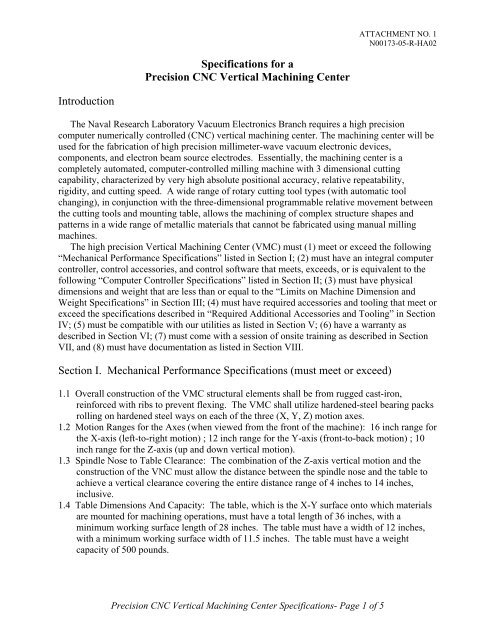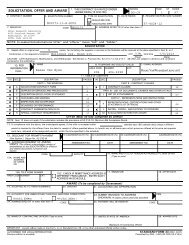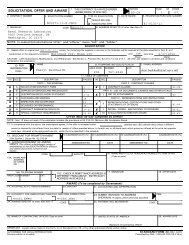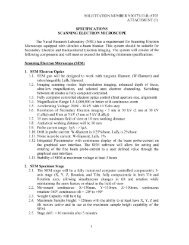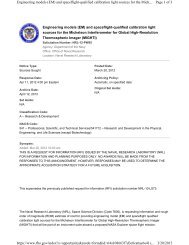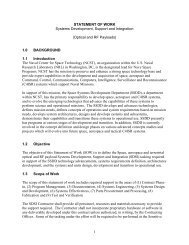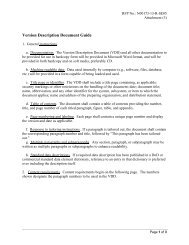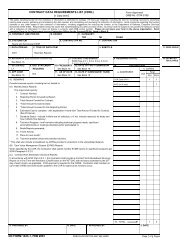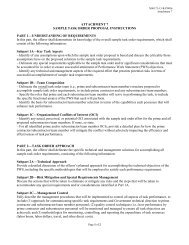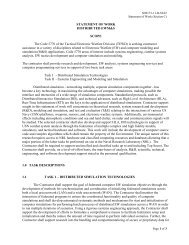Specifications for a Precision CNC Vertical Machining Center ...
Specifications for a Precision CNC Vertical Machining Center ...
Specifications for a Precision CNC Vertical Machining Center ...
Create successful ePaper yourself
Turn your PDF publications into a flip-book with our unique Google optimized e-Paper software.
ATTACHMENT NO. 1<br />
N00173-05-R-HA02<br />
<strong>Specifications</strong> <strong>for</strong> a<br />
<strong>Precision</strong> <strong>CNC</strong> <strong>Vertical</strong> <strong>Machining</strong> <strong>Center</strong><br />
Introduction<br />
The Naval Research Laboratory Vacuum Electronics Branch requires a high precision<br />
computer numerically controlled (<strong>CNC</strong>) vertical machining center. The machining center will be<br />
used <strong>for</strong> the fabrication of high precision millimeter-wave vacuum electronic devices,<br />
components, and electron beam source electrodes. Essentially, the machining center is a<br />
completely automated, computer-controlled milling machine with 3 dimensional cutting<br />
capability, characterized by very high absolute positional accuracy, relative repeatability,<br />
rigidity, and cutting speed. A wide range of rotary cutting tool types (with automatic tool<br />
changing), in conjunction with the three-dimensional programmable relative movement between<br />
the cutting tools and mounting table, allows the machining of complex structure shapes and<br />
patterns in a wide range of metallic materials that cannot be fabricated using manual milling<br />
machines.<br />
The high precision <strong>Vertical</strong> <strong>Machining</strong> <strong>Center</strong> (VMC) must (1) meet or exceed the following<br />
“Mechanical Per<strong>for</strong>mance <strong>Specifications</strong>” listed in Section I; (2) must have an integral computer<br />
controller, control accessories, and control software that meets, exceeds, or is equivalent to the<br />
following “Computer Controller <strong>Specifications</strong>” listed in Section II; (3) must have physical<br />
dimensions and weight that are less than or equal to the “Limits on Machine Dimension and<br />
Weight <strong>Specifications</strong>” in Section III; (4) must have required accessories and tooling that meet or<br />
exceed the specifications described in “Required Additional Accessories and Tooling” in Section<br />
IV; (5) must be compatible with our utilities as listed in Section V; (6) have a warranty as<br />
described in Section VI; (7) must come with a session of onsite training as described in Section<br />
VII, and (8) must have documentation as listed in Section VIII.<br />
Section I. Mechanical Per<strong>for</strong>mance <strong>Specifications</strong> (must meet or exceed)<br />
1.1 Overall construction of the VMC structural elements shall be from rugged cast-iron,<br />
rein<strong>for</strong>ced with ribs to prevent flexing. The VMC shall utilize hardened-steel bearing packs<br />
rolling on hardened steel ways on each of the three (X, Y, Z) motion axes.<br />
1.2 Motion Ranges <strong>for</strong> the Axes (when viewed from the front of the machine): 16 inch range <strong>for</strong><br />
the X-axis (left-to-right motion) ; 12 inch range <strong>for</strong> the Y-axis (front-to-back motion) ; 10<br />
inch range <strong>for</strong> the Z-axis (up and down vertical motion).<br />
1.3 Spindle Nose to Table Clearance: The combination of the Z-axis vertical motion and the<br />
construction of the VNC must allow the distance between the spindle nose and the table to<br />
achieve a vertical clearance covering the entire distance range of 4 inches to 14 inches,<br />
inclusive.<br />
1.4 Table Dimensions And Capacity: The table, which is the X-Y surface onto which materials<br />
are mounted <strong>for</strong> machining operations, must have a total length of 36 inches, with a<br />
minimum working surface length of 28 inches. The table must have a width of 12 inches,<br />
with a minimum working surface width of 11.5 inches. The table must have a weight<br />
capacity of 500 pounds.<br />
<strong>Precision</strong> <strong>CNC</strong> <strong>Vertical</strong> <strong>Machining</strong> <strong>Center</strong> <strong>Specifications</strong>- Page 1 of 5
ATTACHMENT NO. 1<br />
N00173-05-R-HA02<br />
1.5 Mounting Slots: The table must have at least 3 T-slots, with industry-standard T-slot widths<br />
of 0.625 inches (5/8 inches). The slots must be oriented parallel to the X-axis.<br />
1.6 Spindle Requirements: The spindle must have a vertically oriented axis, have an industry<br />
standard #40 taper, and have a computer-controlled continuously variable range of speeds<br />
capable of reaching 15000 RPM (15 thousand revolutions per minute). The spindle must<br />
have a brushless vector drive and it must be capable of creating a torque of 17 foot-pounds<br />
at 4600 RPM. The energizing motor must be capable of developing 15 horsepower under<br />
peak conditions, and 12 horsepower under continuous duty conditions. The energizing<br />
motor must be air cooled.<br />
1.7 Axis Motion Drives: Each of the three axes (X, Y, and Z) must be driven using doubleanchored,<br />
pre-tensioned ball lead screws and associated computer-controlled brushless<br />
motors, and each axis must be capable of creating 2000 pounds of <strong>for</strong>ce, a rapid positioning<br />
feed-rate of 1200 inches per minute, and a controllable cutting rate that can reach a peak of<br />
800 inches per minute.<br />
1.8 Axis Positioning Accuracy: Each of the three axes (X, Y, and Z) must individually exhibit a<br />
positioning accuracy of plus/minus 0.0002 inches (+/- 0.2 thousandths of an inch), and each<br />
of the three axes must individually exhibit a repeatability of plus/minus 0.0001 inches (+/-<br />
0.1 thousandths of an inch).<br />
1.9 Lubrication System: The VMC must come with an automatic lubrication system installed<br />
and capable of lubricating, at a minimum, the ways and ball lead screws of each of the three<br />
(X, Y, Z) motion axes, as well as the spindle bearings.<br />
1.10 Tool Changer: The VMC must have a built-in automatic tool changer, with a capacity of<br />
10 tools based on industry standard CT40 tool type/taper. The changer must be capable of<br />
accommodating tools with weights as large as 12 pounds and diameters reaching 3.5 inches.<br />
The average time between tool changes must be faster than 5 seconds, including transit to<br />
the changer.<br />
1.11 Rigid Tapping: The VMC must be designed and constructed to accommodate rigid<br />
tapping, in which the Z axis motion is synchronized with the spindle rotation during the<br />
tapping process.<br />
1.12 Coolant System: The VMC must have a built-in 3/4 horsepower or greater coolant pump,<br />
sump/reservoir, piping, and nozzles to allow coolant (i.e. machining cutting fluid) to be<br />
directed towards the material being machined and the cutting tools.<br />
1.13 Enclosure: The VMC must have an integral enclosure that surrounds the table, the moving<br />
parts associated with the X, Y, and Z axes, the spindle, the work being machined, as well as<br />
the entire area beneath these regions, in order to protect the operator from flying metal<br />
chips, prevent contact between the operator and moving parts, and to contain and collect the<br />
coolant (cutting fluid) that is being pumped onto the material being machined and the<br />
cutting tool. The enclosure door must be located at the front of the VMC, and it must have a<br />
window to allow viewing of the VMC operation. The enclosure door must have a 22 inch or<br />
greater width and a 22 inch or greater height when opened to allow access to the table and<br />
spindle. The enclosure and leak-preventing caulking can be either factory-installed or fieldinstalled.<br />
<strong>Precision</strong> <strong>CNC</strong> <strong>Vertical</strong> <strong>Machining</strong> <strong>Center</strong> <strong>Specifications</strong>- Page 2 of 5
ATTACHMENT NO. 1<br />
N00173-05-R-HA02<br />
Section II. Computer Controller <strong>Specifications</strong> (must meet, exceed, or be<br />
equivalent to)<br />
2.1 Computer Controller-General: The dedicated computer controller must be capable of<br />
controlling all axes (including an auxiliary fourth axis), the spindle, and the tool changer.<br />
The controller must a designed, integral component of the VMC system solely dedicated to<br />
<strong>CNC</strong> operations and control of the internal functions of the VMC, housed in a manner that is<br />
sufficiently rugged to withstand machine shop conditions, including the presence of stray<br />
metal chips (i.e. attached commercial office or home personal computers are NOT<br />
acceptable).<br />
2.2 Computer Controller Memory and Accessories: The VMC must come with at least 16 MB<br />
factory installed expandable program memory, at least a 20 GB hard disk drive, USB<br />
support, a floppy disk drive, and an Ethernet interface <strong>for</strong> Windows 95, 98, XP, ME, 2000-<br />
PRO & Server NT 4.0.<br />
2.3 Fourth Axis Control: The VMC control system must have driver interfaces and wiring <strong>for</strong><br />
controlling a 4th axis brushless-type rotary table.<br />
2.4 Computer Control Accessories, Software, and Corresponding Support Hardware: Software<br />
to control the machining operations of the VMC, including all axes, the tool changer, and the<br />
spindle, must be supplied with the computer controller. In addition to supporting ISO<br />
industry standard G-code and M-code, the software and control accessories are to include a<br />
Visual Quick Code Programming System <strong>for</strong> <strong>Vertical</strong>s or equivalent (including OMI,<br />
PROMAC, COORD, SO, VQC and QC template files and routines), and associated Probing<br />
Software <strong>for</strong> establishing coordinate references; a tool setting probe; and a work offset probe.<br />
Software to allow cutter compensation, graphic program review, coordinate rotation and<br />
scaling, high speed machining with look ahead capability, and user definable macros (to<br />
create subroutines <strong>for</strong> custom canned cycles, probing routines, operator prompting, math<br />
equations or functions, and family-of-parts machining with variables) is also required. The<br />
controller must accommodate 6 spare M-functions. Spindle Orientation software to allow<br />
indexing the revolution of the spindle to an operator-selected angle (to within 0.1 degree),<br />
using the standard spindle motor and the standard spindle encoder, is required. A home<br />
position button, along with the ability to set an additional (2 nd ) home position, is also<br />
required.<br />
III. Limits on Machine Dimension and Weight <strong>Specifications</strong> (must be less than or<br />
equal to)<br />
3.1 Maximum Machine Weight: The weight of the VMC, after removal of the shipping crate<br />
and prior to any field installed options, must not exceed 4000 pounds. The weight of the<br />
VMC after installation of any field-installed options must not exceed 4300 pounds.<br />
3.2 Maximum VMC Height During Operation: The maximum height of the VMC during<br />
operation must not exceed 98 inches. During on-site assembly procedures or during<br />
temporary maintenance operations, the height may not exceed 102 inches.<br />
3.3 Requirement to Reduce VMC Height During Rigging. After removal from the shipping<br />
crate, but prior to final installation and operation, the height of the VMC needs to be<br />
temporally reduced to 79.5 inches to allow transport and rigging into its final location<br />
<strong>Precision</strong> <strong>CNC</strong> <strong>Vertical</strong> <strong>Machining</strong> <strong>Center</strong> <strong>Specifications</strong>- Page 3 of 5
ATTACHMENT NO. 1<br />
N00173-05-R-HA02<br />
through a freight elevator (allowances <strong>for</strong> rigging equipment height have already been<br />
made). The design of the VMC must allow this height reduction to occur at the delivery site<br />
by simple, standardized procedures that do not require special tooling or training – and<br />
could consist of, <strong>for</strong> example, temporally disconnecting or repositioning the Z-axis conduit<br />
tube and/or associated connections and housings, etc. to the spindle drive, at the onsite<br />
location. Any such temporary procedures must not adversely affect the ultimate<br />
per<strong>for</strong>mance and accuracy of the VMC.<br />
3.4 Maximum VMC Width During Rigging: 65 inches maximum, after removal of the shipping<br />
crate, when viewed from the front of the machine, but be<strong>for</strong>e being readied <strong>for</strong> operation.<br />
3.5 Maximum VMC Width During Operation: 79 inches maximum, when viewed from the<br />
front of the machine, prior to the attachment of any field-installed chip removal accessories.<br />
3.6 Maximum VMC Depth During Rigging: 82 inches maximum, after removal of the shipping<br />
crate, when viewed from the front of the machine, but be<strong>for</strong>e being readied <strong>for</strong> operation.<br />
3.7 Maximum VMC Depth During Operation: 90 inches maximum, when viewed from the<br />
front of the machine.<br />
IV. Required Additional Accessories and Tooling (must include the following<br />
items and meet or exceed the specifications )<br />
4.1 A chip conveyor, auger style with automatic jam sensing and reversal to clear such jams, is<br />
required.<br />
4.2 A programmable coolant nozzle capability, suitably located to direct coolant at the point<br />
where the spindle tooling is cutting or drilling the work piece and including necessary<br />
hardware and control components compatible with the VMC computer controller, is<br />
required.<br />
4.3 A work light, mounted inside the VMC enclosure, is required.<br />
4.4 A set of 24 tooling pull studs, <strong>for</strong> CT40 tooling, is required.<br />
4.5 A cable assembly <strong>for</strong> M-code / MFIN capability is required.<br />
4.6 An early power failure detection module, which will prevent the spindle from dropping in<br />
the event of a power failure, is required.<br />
4.7 A 160 millimeter (6.3 inch) <strong>CNC</strong> rotary table with a brushless wrap around motor and 6<br />
standard T-slots, suitable <strong>for</strong> use as a true <strong>CNC</strong> 4 th axis and compatible with the 4 th axis<br />
control interfaces, wiring, and software associated with the main VMC computer controller,<br />
is required. A quantity of two complete six inch (top) reversible 3-jaw chucks compatible<br />
with the rotary table must also be supplied. A suitable adapter plate <strong>for</strong> mounting the rotary<br />
table to the VMC table, a pneumatic tailstock with a 5 inch center height <strong>for</strong> use with the<br />
rotary table, and a corresponding complete 12 inch by 4 inch tooling block system, a 4.5<br />
inch by 4.5 inch by 12 inch aluminum tombstone, and an A-frame support with 5 inch<br />
center, all suitable <strong>for</strong> use with the rotary table/tailstock assembly, are all required.<br />
4.8 A second <strong>CNC</strong> spindle-type rotary table with a brushless motor, fitted with a A1-6 spindle<br />
nose, and suitable <strong>for</strong> use as a true <strong>CNC</strong> 4 th axis and compatible with the 4 th axis control<br />
interfaces, wiring, and software associated with the main VMC computer controller, is also<br />
required. A pneumatic draw tube with a 1.75 inch ID through hole, and a compatible 5C<br />
collet adapter <strong>for</strong> use in conjunction with this rotary table are required.<br />
4.9 A tool tray <strong>for</strong> holding collets is required. It can be either stand-alone, or mounted inside or<br />
outside the enclosure.<br />
<strong>Precision</strong> <strong>CNC</strong> <strong>Vertical</strong> <strong>Machining</strong> <strong>Center</strong> <strong>Specifications</strong>- Page 4 of 5
ATTACHMENT NO. 1<br />
N00173-05-R-HA02<br />
4.10 A double-sided rolling tool cart that can be used with various tool holder trays, tool boxes,<br />
etc. that are associated with normal operation of the VMC is required.<br />
4.11. A tool holder vise compatible with the 40-taper spindle of the VMC is required.<br />
V. Compatibility with Utilities<br />
5.1 The VMC must be compatible with the following existing utilities:<br />
Power: 230 V, 3-phase AC, 60 A per phase, 60 Hz,<br />
Compressed air: 100-120 psi, 4 CFM<br />
VI. Warranty<br />
6.1 As a minimum, a basic warranty of six months including parts and labor, with an extended<br />
warranty of an additional six months including parts and labor, is required.<br />
VII. Training<br />
7.1 Four (4) hours of on-site training, to occur at the time of installation, is required.<br />
VIII. Documentation.<br />
8.1 NRL requires two (2) copies of an operators manual <strong>for</strong> the complete VMC. This operator’s<br />
manual must include essential maintenance instructions and maintenance schedules as well as<br />
operating instructions.<br />
<strong>Precision</strong> <strong>CNC</strong> <strong>Vertical</strong> <strong>Machining</strong> <strong>Center</strong> <strong>Specifications</strong>- Page 5 of 5


